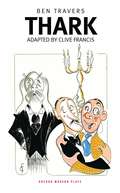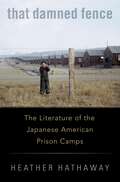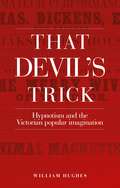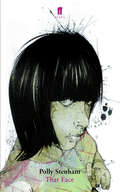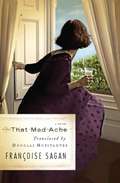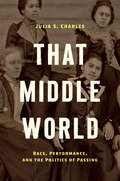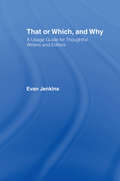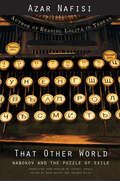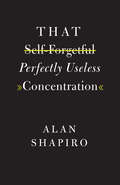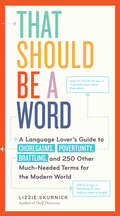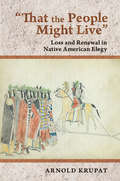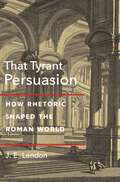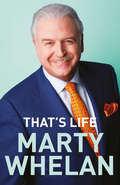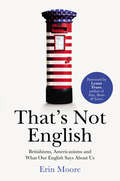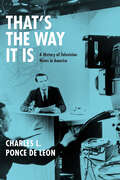- Table View
- List View
Thanking and Politeness in Japanese: Balancing Acts in Interaction
by J. OhashiThis book synthesizes previous work on thanking, politeness and Japanese pragmatics and crystallises the theoretical underpinnings of thanking, how it is realized linguistically and the social meaning and significance of this aspect of Japanese communication.
Thark (Oberon Modern Plays)
by Clive Francis Ben TraversLondon, 1927. Things are not going well for Hector Benbow. His secret liaison with a shop girl is scuppered by his wife’s early arrival home. What’s more, there are reports that Thark – the family home – is haunted. Hector, his plucky nephew Ronny, and the rest of the family set out to the house to prove the rumours wrong. But Thark promises to live up to its spinechilling reputation… This adaptation received its world premiere at Park Theatre in August 2013, directed by Eleanor Rhode, whose previous sellout successes include A Life and the Time Out Critics’ Choice productions of The Drawer Boy and Generous.
That Damned Fence: The Literature of the Japanese American Prison Camps
by Heather HathawayUntil the late twentieth century, relatively few Americans knew that the United States government forcibly detained nearly 120,000 Japanese Americans during World War II. At war's end, the nation, including many of those who were confined to the ten Relocation Centers--which President Roosevelt initially referred to as "concentration camps"--wished to wipe this national tragedy from memory. That Damned Fence, titled after a poem written by a Japanese American held at the Minidoka camp in Idaho, draws on the creative work of the internees themselves to cast new light on this historical injustice. While in captivity, detainees produced moving poetry and fiction, compelling investigative journalism, and lasting work of arts to make sense of their hardships and to leave a record of their emotional and psychological suffering. Heather Hathaway explores the experiences of inmates in five camps--Topaz in Utah; Granada/Amache in Colorado; Rohwer and Jerome in Arkansas; and Tule Lake in northern California--each with their own literary magazines, such as TREK, All Aboard, Pulse, The Pen, Magnet, and The Tulean Dispatch. Conditions in the camps varied dramatically, as did their environments, ranging from sweltering swamplands and sun-blasted desert to frigid mountain terrain. So too did the inhabitants of each camp, with some dominated by farmers from California's Central Valley and others filled with professionals from the San Francisco Bay area. This disparity extended to the attitudes of camp administrators; some deemed the plan a mistake from the outset while others believed their captives to be a significant threat to national security. That Damned Fence reveals the anger and humor, and the deep despair and steadfast resilience with which Japanese Americans faced their wartime incarceration. By emphasizing the inner lives of the unjustly accused and the myriad ways in which they portrayed their captivity, Heather Hathaway gives voice to Americans imprisoned by their own country for their country of origin or appearance.
That Damned Fence: The Literature of the Japanese American Prison Camps
by Heather HathawayUntil the late twentieth century, relatively few Americans knew that the United States government forcibly detained nearly 120,000 Japanese Americans during World War II. At war's end, the nation, including many of those who were confined to the ten Relocation Centers--which President Roosevelt initially referred to as "concentration camps"--wished to wipe this national tragedy from memory. That Damned Fence, titled after a poem written by a Japanese American held at the Minidoka camp in Idaho, draws on the creative work of the internees themselves to cast new light on this historical injustice. While in captivity, detainees produced moving poetry and fiction, compelling investigative journalism, and lasting work of arts to make sense of their hardships and to leave a record of their emotional and psychological suffering. Heather Hathaway explores the experiences of inmates in five camps--Topaz in Utah; Granada/Amache in Colorado; Rohwer and Jerome in Arkansas; and Tule Lake in northern California--each with their own literary magazines, such as TREK, All Aboard, Pulse, The Pen, Magnet, and The Tulean Dispatch. Conditions in the camps varied dramatically, as did their environments, ranging from sweltering swamplands and sun-blasted desert to frigid mountain terrain. So too did the inhabitants of each camp, with some dominated by farmers from California's Central Valley and others filled with professionals from the San Francisco Bay area. This disparity extended to the attitudes of camp administrators; some deemed the plan a mistake from the outset while others believed their captives to be a significant threat to national security. That Damned Fence reveals the anger and humor, and the deep despair and steadfast resilience with which Japanese Americans faced their wartime incarceration. By emphasizing the inner lives of the unjustly accused and the myriad ways in which they portrayed their captivity, Heather Hathaway gives voice to Americans imprisoned by their own country for their country of origin or appearance.
That devil's trick: Hypnotism and the Victorian popular imagination
by William HughesThat devil’s trick is the first study of nineteenth-century hypnotism based primarily on the popular – rather than medical – appreciation of the subject. Drawing on the reports of mesmerists, hypnotists, quack doctors and serious physicians printed in popular newspapers from the early years of the nineteenth century to the Victorian fin de siècle, the book provides an insight into how continental mesmerism was first understood in Britain, how a number of distinctively British varieties of mesmerism developed, and how these were continually debated in medical, moral and legal terms. Highly relevant to the study of the many authors – Charles Dickens, George Eliot, Bram Stoker and Conan Doyle among them – whose fiction was informed by the imagery of mesmerism, That devil’s trick will be an essential resource for anybody with an interest in the popular and literary culture of the nineteenth century, including literary scholars, medical historians and the general reader.
That devil's trick: Hypnotism and the Victorian popular imagination
by William HughesThat devil’s trick is the first study of nineteenth-century hypnotism based primarily on the popular – rather than medical – appreciation of the subject. Drawing on the reports of mesmerists, hypnotists, quack doctors and serious physicians printed in popular newspapers from the early years of the nineteenth century to the Victorian fin de siècle, the book provides an insight into how continental mesmerism was first understood in Britain, how a number of distinctively British varieties of mesmerism developed, and how these were continually debated in medical, moral and legal terms. Highly relevant to the study of the many authors – Charles Dickens, George Eliot, Bram Stoker and Conan Doyle among them – whose fiction was informed by the imagery of mesmerism, That devil’s trick will be an essential resource for anybody with an interest in the popular and literary culture of the nineteenth century, including literary scholars, medical historians and the general reader.
That Face
by Polly StenhamI can't take care of you anymore. I can't take it. It's like an endless boxing match.Mia is at boarding school. She has access to drugs. They are Martha's. Henry is preparing for art college. He has access to alcohol. From Martha. Martha controls their lives. Martha is their mother.That Face premiered at the Royal Court Theatre, London, in April 2007, and won the TMA Award 2007 for Best New Play. Polly Stenham received both the Charles Wintour Award 2007 and the Critics' Circle Award 2008 for Most Promising Playwright.
That Mad Ache: A Novel
by Françoise SaganThat Mad Ache, set in high-society Paris in the mid-1960&’s, recounts the emotional battle unleashed in the heart of Lucile, a sensitive but rootless young woman who finds herself caught between her carefree, tranquil love for 50-year-old Charles, a gentle, reflective, and well-off businessman, and her sudden wild passion for 30-year-old Antoine, a hot-blooded, impulsive, and struggling editor. As Lucile explores these two versions of love, she vacillates in confusion, but in the end she must choose, and her heart&’s instinct is surprising and poignant. Originally published under the title La Chamade, this new translation by Douglas Hofstadter returns a forgotten classic to English.In Translator, Trader, Douglas Hofstadter reflects on his personal act of devotion in rewriting Françoise Sagan&’s novel La Chamade in English, and on the paradoxes that constantly plague any literary translator on all scales, ranging from the humblest of commas to entire chapters. Flatly rejecting the common wisdom that translators are inevitably traitors, Hofstadter proposes instead that translators are traders, and that translation, like musical performance, deserves high respect as a creative act. In his view, literary translation is the art of making subtle trades in which one sometimes loses and sometimes gains, often both losing and gaining at the same time. This view implies that there is no reason a translation cannot be as good as the original work, and that the result inevitably bears the stamp of the translator, much as a musical performance inevitably bears the stamp of its artists. Both a companion to the beloved Sagan novel and a singular meditation on translation, Translator, Trader is a witty and intimate exploration of words, ideas, communication, creation, and faithfulness.
That Mad Ache: A Novel
by Françoise SaganThat Mad Ache, set in high-society Paris in the mid-1960's, recounts the emotional battle unleashed in the heart of Lucile, a sensitive but rootless young woman who finds herself caught between her carefree, tranquil love for 50-year-old Charles, a gentle, reflective, and well-off businessman, and her sudden wild passion for 30-year-old Antoine, a hot-blooded, impulsive, and struggling editor. As Lucile explores these two versions of love, she vacillates in confusion, but in the end she must choose, and her heart's instinct is surprising and poignant. Originally published under the title La Chamade, this new translation by Douglas Hofstadter returns a forgotten classic to English. In Translator, Trader, Douglas Hofstadter reflects on his personal act of devotion in rewriting Francoise Sagan's novel La Chamade in English, and on the paradoxes that constantly plague any literary translator on all scales, ranging from the humblest of commas to entire chapters. Flatly rejecting the common wisdom that translators are inevitably traitors, Hofstadter proposes instead that translators are traders, and that translation, like musical performance, deserves high respect as a creative act. In his view, literary translation is the art of making subtle trades in which one sometimes loses and sometimes gains, often both losing and gaining at the same time. This view implies that there is no reason a translation cannot be as good as the original work, and that the result inevitably bears the stamp of the translator, much as a musical performance inevitably bears the stamp of its artists. Both a companion to the beloved Sagan novel and a singular meditation on translation, Translator, Trader is a witty and intimate exploration of words, ideas, communication, creation, and faithfulness.
That Middle World: Race, Performance, and the Politics of Passing
by Julia S. CharlesIn this study of racial passing literature, Julia S. Charles highlights how mixed-race subjects invent cultural spaces for themselves—a place she terms that middle world—and how they, through various performance strategies, make meaning in the interstices between the Black and white worlds. Focusing on the construction and performance of racial identity in works by writers from the antebellum period through Reconstruction, Charles creates a new discourse around racial passing to analyze mixed-race characters' social objectives when crossing into other racialized spaces. To illustrate how this middle world and its attendant performativity still resonates in the present day, Charles connects contemporary figures, television, and film—including Rachel Dolezal and her Black-passing controversy, the FX show Atlanta, and the musical Show Boat—to a range of nineteenth- and early twentieth-century literary texts. Charles's work offers a nuanced approach to African American passing literature and examines how mixed-race performers articulated their sense of selfhood and communal belonging.
That or Which, and Why: A Usage Guide for Thoughtful Writers and Editors
by Evan JenkinsThat or Which, and Why is an insightful and witty guide to writing. Based on Evan Jenkins's long-running column 'Language Corner' in Columbia Journalism Review, the book is compiled of brief, alphabetically arranged entries on approximately 200 major writing stumbling blocks, from the wonderful world of 'that' and 'which' to trickier terrain like the correct usage of common idiomatic expressions.Working from his experiences as a newsroom editor and teacher, Jenkins' humorous tone puts the reader at ease, unlike many of the writing and usage guides out there that are off-putting in their rigidity and dogmatism. He takes the 'we're-all-in-this-together' approach to teaching better writing - maintaining a light tone throughout the book and emphasizing flexibility and easy-to-use guidelines rather than delivering orders from Grammar-on-high.
That or Which, and Why: A Usage Guide for Thoughtful Writers and Editors
by Evan JenkinsThat or Which, and Why is an insightful and witty guide to writing. Based on Evan Jenkins's long-running column 'Language Corner' in Columbia Journalism Review, the book is compiled of brief, alphabetically arranged entries on approximately 200 major writing stumbling blocks, from the wonderful world of 'that' and 'which' to trickier terrain like the correct usage of common idiomatic expressions.Working from his experiences as a newsroom editor and teacher, Jenkins' humorous tone puts the reader at ease, unlike many of the writing and usage guides out there that are off-putting in their rigidity and dogmatism. He takes the 'we're-all-in-this-together' approach to teaching better writing - maintaining a light tone throughout the book and emphasizing flexibility and easy-to-use guidelines rather than delivering orders from Grammar-on-high.
That Other World: Nabokov and the Puzzle of Exile
by Azar NafisiThe foundational text for the acclaimed New York Times and international best seller Reading Lolita in Tehran The ruler of a totalitarian state seeks validation from a former schoolmate, now the nation’s foremost thinker, in order to access a cultural cache alien to his regime. A literary critic provides commentary on an unfinished poem that both foretells the poet’s death and announces the critic’s secret identity as the king of a lost country. The greatest of Vladimir Nabokov’s enchanters—Humbert—is lost within the antithesis of a fairy story, in which Lolita does not hold the key to his past but rather imprisons him within the knowledge of his distance from that past. In this precursor to her international best seller Reading Lolita in Tehran, Azar Nafisi deftly explores the worlds apparently lost to Nabokov’s characters, their portals of access to those worlds, and how other worlds hold a mirror to Nabokov’s experiences of physical, linguistic, and recollective exile. Written before Nafisi left the Islamic Republic of Iran, and now published in English for the first time and with a new introduction by the author, this book evokes the reader’s quintessential journey of discovery and reveals what caused Nabokov to distinctively shape and reshape that journey for the author.
That Self-Forgetful Perfectly Useless Concentration
by Alan ShapiroMore than a gathering of essays, That Self-Forgetful Perfectly Useless Concentration is part memoir, part literary criticism, and an artful fusion of the two. It is an intimate portrait of a life in poetry that only Alan Shapiro could have written. In this book, Shapiro brings his characteristic warmth, humor, and many years as both poet and teacher to bear on questions surrounding two preoccupations: the role of conventions—of literary and social norms—in how we fashion our identities on and off the page, and how suffering both requires and resists self-expression. He sketches affectionate portraits of his early teachers, revisits the deaths of his brother and sister, and examines poems that have helped him navigate troubled times. Integrating storytelling and literary analysis so seamlessly that art and life become extensions of each other, Shapiro embodies in his lively prose the very qualities he celebrates in the poems he loves. Brimming with wit and insight, this is a book for poets, students and scholars of poetry, teachers of literature, and everyone who cares about the literary arts and how they illuminate our personal and public lives.
That Self-Forgetful Perfectly Useless Concentration
by Alan ShapiroMore than a gathering of essays, That Self-Forgetful Perfectly Useless Concentration is part memoir, part literary criticism, and an artful fusion of the two. It is an intimate portrait of a life in poetry that only Alan Shapiro could have written. In this book, Shapiro brings his characteristic warmth, humor, and many years as both poet and teacher to bear on questions surrounding two preoccupations: the role of conventions—of literary and social norms—in how we fashion our identities on and off the page, and how suffering both requires and resists self-expression. He sketches affectionate portraits of his early teachers, revisits the deaths of his brother and sister, and examines poems that have helped him navigate troubled times. Integrating storytelling and literary analysis so seamlessly that art and life become extensions of each other, Shapiro embodies in his lively prose the very qualities he celebrates in the poems he loves. Brimming with wit and insight, this is a book for poets, students and scholars of poetry, teachers of literature, and everyone who cares about the literary arts and how they illuminate our personal and public lives.
That Self-Forgetful Perfectly Useless Concentration
by Alan ShapiroMore than a gathering of essays, That Self-Forgetful Perfectly Useless Concentration is part memoir, part literary criticism, and an artful fusion of the two. It is an intimate portrait of a life in poetry that only Alan Shapiro could have written. In this book, Shapiro brings his characteristic warmth, humor, and many years as both poet and teacher to bear on questions surrounding two preoccupations: the role of conventions—of literary and social norms—in how we fashion our identities on and off the page, and how suffering both requires and resists self-expression. He sketches affectionate portraits of his early teachers, revisits the deaths of his brother and sister, and examines poems that have helped him navigate troubled times. Integrating storytelling and literary analysis so seamlessly that art and life become extensions of each other, Shapiro embodies in his lively prose the very qualities he celebrates in the poems he loves. Brimming with wit and insight, this is a book for poets, students and scholars of poetry, teachers of literature, and everyone who cares about the literary arts and how they illuminate our personal and public lives.
That Self-Forgetful Perfectly Useless Concentration
by Alan ShapiroMore than a gathering of essays, That Self-Forgetful Perfectly Useless Concentration is part memoir, part literary criticism, and an artful fusion of the two. It is an intimate portrait of a life in poetry that only Alan Shapiro could have written. In this book, Shapiro brings his characteristic warmth, humor, and many years as both poet and teacher to bear on questions surrounding two preoccupations: the role of conventions—of literary and social norms—in how we fashion our identities on and off the page, and how suffering both requires and resists self-expression. He sketches affectionate portraits of his early teachers, revisits the deaths of his brother and sister, and examines poems that have helped him navigate troubled times. Integrating storytelling and literary analysis so seamlessly that art and life become extensions of each other, Shapiro embodies in his lively prose the very qualities he celebrates in the poems he loves. Brimming with wit and insight, this is a book for poets, students and scholars of poetry, teachers of literature, and everyone who cares about the literary arts and how they illuminate our personal and public lives.
That Self-Forgetful Perfectly Useless Concentration
by Alan ShapiroMore than a gathering of essays, That Self-Forgetful Perfectly Useless Concentration is part memoir, part literary criticism, and an artful fusion of the two. It is an intimate portrait of a life in poetry that only Alan Shapiro could have written. In this book, Shapiro brings his characteristic warmth, humor, and many years as both poet and teacher to bear on questions surrounding two preoccupations: the role of conventions—of literary and social norms—in how we fashion our identities on and off the page, and how suffering both requires and resists self-expression. He sketches affectionate portraits of his early teachers, revisits the deaths of his brother and sister, and examines poems that have helped him navigate troubled times. Integrating storytelling and literary analysis so seamlessly that art and life become extensions of each other, Shapiro embodies in his lively prose the very qualities he celebrates in the poems he loves. Brimming with wit and insight, this is a book for poets, students and scholars of poetry, teachers of literature, and everyone who cares about the literary arts and how they illuminate our personal and public lives.
That Self-Forgetful Perfectly Useless Concentration
by Alan ShapiroMore than a gathering of essays, That Self-Forgetful Perfectly Useless Concentration is part memoir, part literary criticism, and an artful fusion of the two. It is an intimate portrait of a life in poetry that only Alan Shapiro could have written. In this book, Shapiro brings his characteristic warmth, humor, and many years as both poet and teacher to bear on questions surrounding two preoccupations: the role of conventions—of literary and social norms—in how we fashion our identities on and off the page, and how suffering both requires and resists self-expression. He sketches affectionate portraits of his early teachers, revisits the deaths of his brother and sister, and examines poems that have helped him navigate troubled times. Integrating storytelling and literary analysis so seamlessly that art and life become extensions of each other, Shapiro embodies in his lively prose the very qualities he celebrates in the poems he loves. Brimming with wit and insight, this is a book for poets, students and scholars of poetry, teachers of literature, and everyone who cares about the literary arts and how they illuminate our personal and public lives.
That Should Be a Word: A Language Lover's Guide to Choregasms, Povertunity, Brattling, and 250 Other Much-Needed Terms for the Modern World
by Lizzie SkurnickFinally there&’s a word for it: Fidgital—excessively checking one&’s devices. Martyrmony—staying married out of duty. Author of the highly popular &“That Should Be a Word&” feature in the New York Times Magazine, Lizzie Skurnick delights word lovers with razor-sharp social commentary delivered via clever neologisms. That Should Be a Word is a compendium of 244 of Skurnick&’s wittiest wordplays—more than half of them new—arranged in ingenious diagrams detailing their interrelationships. Complete with definitions, pronunciations, usage examples, and illustrations, That Should Be a Word features words on our obsession with food: carbiter—one who asserts that someone else cannot be hungry. On social media, like twiticule—to mock someone in 140 characters. On the modern family, like brattle—to discuss one&’s children at great length, which leads to words like spamily—Facebook or Twitter updates about kids—and spawntourage—a group of approaching strollers. From highlighting the profound financial anxiety of a post-recession society (bangst) to mocking the hyper-vain celebrity circle that abstains from anything of import (celebracy), That Should Be a Word delves deep into all the most humorous, and maddening, aspects of life in the 21st century.
"That the People Might Live": Loss and Renewal in Native American Elegy
by Arnold KrupatThe word "elegy" comes from the Ancient Greek elogos, meaning a mournful poem or song, in particular, a song of grief in response to loss. Because mourning and memorialization are so deeply embedded in the human condition, all human societies have developed means for lamenting the dead, and, in "That the People Might Live," Arnold Krupat surveys the traditions of Native American elegiac expression over several centuries. Krupat covers a variety of oral performances of loss and renewal, including the Condolence Rites of the Iroquois and the memorial ceremony of the Tlingit people known as koo’eex, examining as well a number of Ghost Dance songs, which have been reinterpreted in culturally specific ways by many different tribal nations. Krupat treats elegiac "farewell" speeches of the eighteenth and nineteenth centuries in considerable detail, and comments on retrospective autobiographies by Black Hawk and Black Elk. Among contemporary Native writers, he looks at elegiac work by Linda Hogan, N. Scott Momaday, Gerald Vizenor, Sherman Alexie, Maurice Kenny, and Ralph Salisbury, among others. Despite differences of language and culture, he finds that death and loss are consistently felt by Native peoples both personally and socially: someone who had contributed to the People’s well-being was now gone. Native American elegiac expression offered mourners consolation so that they might overcome their grief and renew their will to sustain communal life.
That Tyrant, Persuasion: How Rhetoric Shaped the Roman World
by J. E. LendonHow rhetorical training influenced deeds as well as words in the Roman EmpireThe assassins of Julius Caesar cried out that they had killed a tyrant, and days later their colleagues in the Senate proposed rewards for this act of tyrannicide. The killers and their supporters spoke as if they were following a well-known script. They were. Their education was chiefly in rhetoric and as boys they would all have heard and given speeches on a ubiquitous set of themes—including one asserting that &“he who kills a tyrant shall receive a reward from the city.&” In That Tyrant, Persuasion, J. E. Lendon explores how rhetorical education in the Roman world influenced not only the words of literature but also momentous deeds: the killing of Julius Caesar, what civic buildings and monuments were built, what laws were made, and, ultimately, how the empire itself should be run.Presenting a new account of Roman rhetorical education and its surprising practical consequences, That Tyrant, Persuasion shows how rhetoric created a grandiose imaginary world for the Roman ruling elite—and how they struggled to force the real world to conform to it. Without rhetorical education, the Roman world would have been unimaginably different.
That’s Life – Marty Whelan’s Memoir: A Life through Music
by Marty WhelanFrom Norman Wisdom to Eurovision and everything in between, a lively and entertaining memoir from one of Ireland’s best-loved personalities.Throughout the highs and lows of a 30-year career as one of Ireland’s best-loved radio and television personalities, Marty Whelan has always remained upbeat, with a determination for survival and an enthusiasm for life.In this warm and witty memoir, Marty takes inspiration from the songs that have had meaning in his life as he explores some big themes – love, heroes, family, friendship, music, childhood and spirituality – by way of Bruce Springsteen, David Bowie, Glen Campbell, Paul McCartney, The Three Degrees, Frank Sinatra and Madama Butterfly.Although he is one of Ireland’s national treasures, Marty has never stopped being a fan himself. That’s Life describes his many wonderful adventures, up close and personal with his own heroes: getting to bring his beloved mum to tea with her idol Norman Wisdom, forgetting how to speak on coming face-to-face with Al Pacino, entertaining Spike Milligan and dancing in the dark with Bruce Springsteen.And yet at the heart of the book is the story of the man himself, from growing up as an only child to his brief spell in a band (that couldn’t write any songs), from dating in Dublin in the seventies to leaving his insurance job during lunch hour for his first broadcasting gigs on pirate radio, and on to the many family highs and occasional heartaches.A great man for the tangent – you’ll find you have to stop off a few times for the odd joke – Marty will take you on a whirlwind journey through a life fully lived, but most of all a life filled with love, laughter, family and friendship.
That's Not English: Britishisms, Americanisms and What Our English Says About Us
by Erin MooreIn this brilliant transatlantic survival guide, Erin Moore examines the key differences between the British and the Americans through their language. You’ll discover why Americans give – and take – so many bloody compliments and never, ever say ‘shall’ (well hardly ever), as well as what the British really mean when they say ‘proper’, why they believe it is better to be bright than clever and how the word sorry has at least eight different meanings for them.
That's the Way It Is: A History of Television News in America
by Charles L. Ponce de LeonWhen critics decry the current state of our public discourse, one reliably easy target is television news. It’s too dumbed-down, they say; it’s no longer news but entertainment, celebrity-obsessed and vapid. The critics may be right. But, as Charles L. Ponce de Leon explains in That’s the Way It Is, TV news has always walked a fine line between hard news and fluff. The familiar story of decline fails to acknowledge real changes in the media and Americans’ news-consuming habits, while also harking back to a golden age that, on closer examination, is revealed to be not so golden after all. Ponce de Leon traces the entire history of televised news, from the household names of the late 1940s and early ’50s, like Eric Sevareid, Edward R. Murrow, and Walter Cronkite, through the rise of cable, the political power of Fox News, and the satirical punch of Colbert and Stewart. He shows us an industry forever in transition, where newsmagazines and celebrity profiles vie with political news and serious investigations. The need for ratings success—and the lighter, human interest stories that can help bring it—Ponce de Leon makes clear, has always sat uneasily alongside a real desire to report hard news. Highlighting the contradictions and paradoxes at the heart of TV news, and telling a story rich in familiar figures and fascinating anecdotes, That’s the Way It Is will be the definitive account of how television has showed us our history as it happens.

